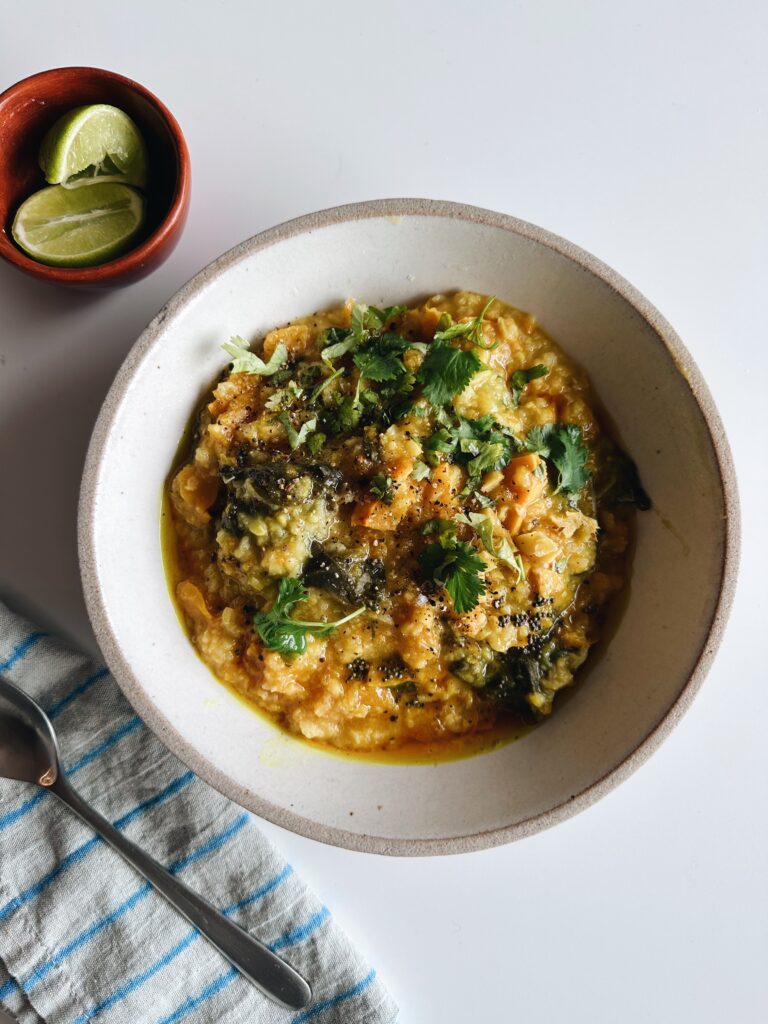

When you need a reset from the inside out, this is what to cook.
This kitchari is an absolute staple in my winter kitchen. Whenever I over-do it; with travel, with excitement, with training, with work, I make kitchari. Whenever I feel the impact of too many foods not in line with my constitution, I make kitchari. Whenever I feel overwhelmed, need a rest from the inside out, or just want to get my being back into balance (in a way that a pint of ice cream or a box of macaroni and cheese can’t *quite* touch.)
Ayurveda recognizes that balance comes from opposites. If we have a rough day, or endure “hard” experiences the way we eat must be smooth and soft. Truly. It’s that simple. And this kitchari is all that. Rice and moong dal cook together to make the most delicious bowl of simple, spiced not-quite-soup, not-quite-porridge
But the other superpower present in this simple bowl are the Six Flavors which (as you’re learning) is the hallmark of a meal being not just healthful, but satisfying in a way that won’t spark cravings for “something” later. And, indicates to the body that all of the bioenergetic benefits we need from our food are present.
Lastly, this traditional kitchari is a simple-to-digest food that also offers a complete macronutrient profile; fats, carbohydrates and proteins. All ingredients we need to balance, restore and revitalize.
Whether you’re coaxing your digestive system back to a balanced state after the holidays, recovering from a challenging workout, a heartbreak of just a busy week at work – this Winter Squash Kitchari is where it’s at.

Just like all of our meals, it’s important to make kitchari with seasonal vegetables. Other kitchari recipes I know and love (to include this one) contain ingredients not present in the winter, which means they aren’t really providing what our bodies need during this coldest time of year. But sweet squash and bitter, astringent hardy winter greens help nourish the body, and also balance the pH of our systems, cooling inflammation, soothing the digestive system and helping the body to detox at the same time.
As we work out way through winter, it’s important that we focus on eating nutritionally dense foods that will help to keep the body warm, help the body to nourish and replenish stores burned in other times of year, and encourage deep recovery. Winter is the season of Vata, and it arrives cold, blustery, subtle, mobile, grating, and rough. Enjoying foods – and practices – that are warm, moisturizing, dense, grounding and easy is the goal to help center and balance our bodies in the wind, AND to generate the kind of moisture we require to keep our systems functioning highly all season long. If we don’t balance well, we end up with excess dryness, coldness and weakness in the body as the weather warms, and this leads to reduced immunity, congestion, and sicknesses come spring (not to mention unwanted weight carried into summer.)

To enjoy a bowl of kitchari naked is missing a big part of the perk of eating it at all. To make it the “real deal,” and to make sure that you get all Six Flavors into this bowl, I strongly suggest serving it with a healthy dollop of ghee (1-2 tsp,) a squeeze of fresh lime juice, a sprinkle of fresh ginger, a little freshly chopped cilantro, a pinch of flaky sea salt and a few cracks of fresh black pepper. AND, the sizzled spices thatare an added – but worthwhile step – in this recipe. Sizzling the spices opens up the valuable oils, making them bioavailable and helping them to warm the body and further reduce inflammation and heal recovery. This is important because it provides a bit of extra critical fat, a sour punch, and amps up the pungent notes of this dish – all of which help make it satisfying, digestible, complete and SO GOOD.
That's ok, just sign up or log in to see this recipe.